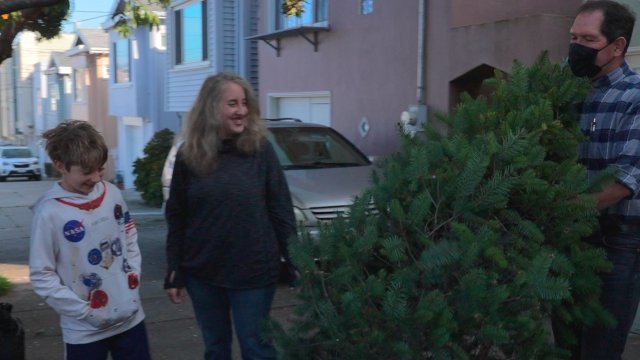Christmas tree dealers across the country are reporting shortages this year. But, for some, it’s not an issue.
A patch of forest in Northern California is home to living trees that leave their year-round home to go off on holiday excursions.
This year, Monica Hudson is renting out nearly 700 trees.
"Slowly but surely, the field is getting more empty," Hudson said. "This tree, for example, has been to Christmas four years in a row. This will be the fifth time it's going to be spending the holidays with a family."
This is her twelfth season seeing off trees as they're delivered to homes within a service area that includes Silicon Valley.
Tree loyalty drives much of Hudson's business.
Diane Shapiro says she sought out a living Christmas tree after her son, Aiden, noticed a grove of trees being cut down to make way for new condos on the drive to school.
"He's like, 'But why would they cut the trees down? It's sad that they're cutting all the trees down,'" Shapiro said. "And then December rolled around. I really didn't want to bring in a cut Christmas tree after that experience because I thought, 'What am I going to tell my son?'"
But finding a living tree that could to be delivered to San Francisco wasn't easy. The first two companies she used went out of business. Hudson agreed to ship to her from two hours away in Monterey if she could recruit seven other renters in her area, which she did.
NEWSY'S JASON BELLINI: Why do you get the same tree?
DIANE SHAPIRO: It's fun. It's like it's kind of like the tree becomes part of your family.
AIDEN SHAPRIO: Yeah. We get to see the tree grow until it gets too tall, then we have to get a new tree.
BELLINI: All these trees right here — where do they come from?
MONICA HUDSON: We have a grower in Oregon that starts them for us. We are here in Carmel and the central coast of California, and there is a water shortage. So, for us to start the trees from seedlings that are about the size of your index finger and water them for five years or six years before they get to be that size would be prohibitive.
BELLINI: Will they ever be able to retire from duty and be in the ground?
HUDSON: When they get too big we try to find a home for them... a retirement home in the ground. When they are maybe 10 feet, we sell them off, or sometimes give them away to be planted. That's the hope is that the trees will go on living.
That's not the fate of the nearly 30 million trees cut down in the U.S. each year for Christmas. Most end up in landfills. The industry says its practices are sustainable, the trees recyclable.
BELLINI: When people rent a tree, they have responsibility for that tree?
HUDSON: They do.
BELLINI: What happens if they're not watering it every day? You said they need to water it every day, right?
HUDSON: That is correct. Yes. And we do have an agreement with our customers. They sign the paperwork that they promised to water every day. If that doesn't happen and the trees show signs of stress, we have to notify them and they can be liable for the cost of the tree.
Hudson estimates that happens with less than one percent of her rentals.
For the 30-day rental, a big tree could cost around $200, but Hudson isn't getting rich doing the job. She says it's an incredible amount of hard work for a not so great return financially, but it does help something else.
"We've had these fires in California," Hudson said. "Some people have wanted to reforest areas, and that has brought us to the realization — we would have no problem finding places for them to grow for the rest of their life. And that's why we are experimenting very successfully with Redwood trees."
One of the gifts of renting a tree is the fact it may well outlive the people for whom they create Christmas memories.
This year, nearly all of the trees have families.
This story was originally published by Jason Bellini on Newsy.com.


